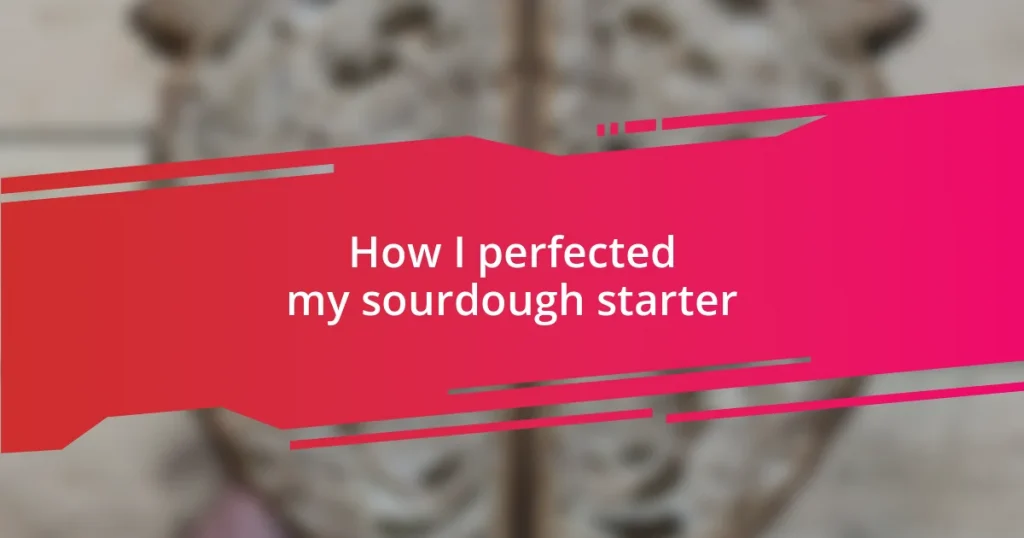Key takeaways:
- A sourdough starter requires regular feeding, a suitable temperature, and an appropriate flour type to thrive.
- Water quality and temperature significantly affect fermentation; warm, filtered water enhances yeast activity.
- Maintaining a consistent feeding schedule and storage method (like refrigeration) ensures the health and vitality of the starter.

Understanding sourdough starters
A sourdough starter is essentially a living culture of flour and water that captures wild yeast and beneficial bacteria from the environment. It fascinates me how this simple mixture can transform over time into something so complex, leading to the tangy flavor and airy texture we love in sourdough bread. Have you ever thought about the science behind that bubbling activity? It feels magical to watch it grow.
When I first started my sourdough journey, I was overwhelmed by the idea that my success depended on this little jar of fermenting goodness. I still remember the moment I discovered that the starter needed regular feedings and just the right temperature to thrive. It’s almost like nurturing a pet—you start to feel a connection, checking on it throughout the day as if it were a low-maintenance roommate.
One unique aspect of sourdough starters is their individuality; no two starters are exactly alike. The specific microorganisms thriving in your starter are influenced by your local environment, which imparts a character distinct to your region. Doesn’t it make you wonder how many stories a starter could tell if it could speak? Each loaf you bake is not just a product; it’s a reflection of your unique starter, shaped by your care and the elements around you.

Selecting the right flour
Selecting the right flour for your sourdough starter is more than just a technical choice; it’s an intimate relationship you’ll cultivate over time. When I first explored different types of flour, it was like stepping into a world full of flavors waiting to be unleashed. Each variety not only contributed to the starter’s growth but deeply influenced the character of my bread.
I personally found that using unbleached all-purpose flour gave my starter a great balance. It was forgiving yet responsive, allowing me to learn and experiment without overwhelming pressure. This type of flour is widely available, but if you’re looking for something more artisanal, consider using whole grain flours. Whole wheat flour, for instance, provides more nutrients, giving a robust flavor and promoting active yeast growth, but I remember it was a bit trickier to manage.
After some trials, I also discovered that rye flour is a fantastic choice for kickstarting a new starter. I once mixed it with all-purpose flour, and the result was simply astonishing! The unique blend created a bubbly, active starter that propelled my baking to a level I hadn’t anticipated. Isn’t it interesting how something as simple as flour can vastly change your baking journey?
| Type of Flour | Characteristics |
|---|---|
| All-Purpose Flour | Versatile, balanced, easy to obtain |
| Whole Wheat Flour | Nutritious, robust flavor, but can be harder to manage |
| Rye Flour | Promotes rapid yeast growth, unique flavor, great for starters |

Water temperature and quality
Water temperature plays a crucial role in the development of my sourdough starter. I’ve learned through experience that using warm water, ideally around 75-80°F (24-27°C), encourages the yeast and bacteria to awaken more actively. Conversely, cold water can slow down fermentation, leaving you waiting anxiously for signs of life in the jar. I can still recall the day I decided to use slightly cooler water out of curiosity and ended up waiting for days to see any bubbling—frustrating, to say the least!
- Warm water boosts fermentation activity.
- Cold water can stifle growth and prolong development time.
- Room temperature water (about 68-72°F or 20-22°C) can be a safe, balanced choice.
The quality of water is equally important. I’ve become particularly mindful of the water I use, weighing the pros and cons of tap versus filtered water. When I relied on tap water, I noticed a lingering chlorine taste in my bread, which was less than desirable. Switching to filtered water not only improved my starter’s health but also enhanced the overall flavor of my sourdough—like unlocking a hidden layer of deliciousness!
- Chlorine in tap water can inhibit yeast activity.
- Filtered water promotes a healthier environment for fermentation.
- Mineral content in water can subtly influence the taste of your bread.

Feeding schedule for success
Maintaining a consistent feeding schedule is essential for nurturing a thriving sourdough starter. I remember when I first started, I was eager to experiment but often found myself neglecting the schedule. I quickly learned that regular feedings—in my case, every 12 hours—kept my starter bubbly and active. It was a game-changer! Consistency feeds not just the microorganisms but also my confidence in baking.
When I upgraded my feeding frequency, I was pleasantly surprised by how my starter responded. I noticed that using a 1:1:1 ratio of flour to water to starter helped balance things out nicely. It felt almost like having a pet—I could see its growth and transformation with each feeding. Have you ever had that moment when you realize your starter is actually alive and thriving? It’s like a little miracle in a jar!
The temperature at which you feed can also play a significant role in the schedule’s success. I remember one Saturday morning when I forgot to move my starter to a warmer spot after a late feeding. By the time I got back to it, it had stalled. It taught me that keeping my starter in a consistent, warm environment truly harmonized its development. I now allow it to settle near a warm window—my little lazy sunbather! Perhaps this simple act can make all the difference in your sourdough journey, too.

Signs of a healthy starter
It’s truly exciting to see a healthy sourdough starter at work! One of the first indicators for me was the vibrant bubbling action. When I noticed those air bubbles rising to the surface after a good feed, it felt like watching my starter come to life. I often ask myself: Isn’t it fascinating that all of that activity happens thanks to the tiny microorganisms doing their job?
Another sign I picked up on was the delightful aroma. A healthy starter gives off a pleasant, slightly tangy scent—nothing like that sour, overpowering smell when things go wrong. I remember one time when I neglected my starter for a bit too long; the sour smell had me worried, and I considered tossing it out. Instead, I decided to feed it and give it one last chance. Much to my surprise, my starter rebounded beautifully, and the smell transformed back to something appetizing. It’s those little victories that keep me going!
Lastly, the rise and fall pattern is key. A healthy starter will double in size within a few hours of feeding and subsequently deflate as it uses up the sugars. I’ve often been mesmerized by this cycle—like watching a gentle dance. Have you ever timed your feedings just to witness this transformation? There’s a special satisfaction in realizing that your starter is not just surviving, but thriving, and it makes all the effort worthwhile.

Troubleshooting common issues
I recall a time when my starter simply refused to rise, and I was left frustrated. It was a classic case of either underfeeding or overfeeding. At that moment, I had to take a step back and assess the situation. Did I alter my routine or introduce a new flour? I ended up adjusting to a more regular feeding cycle and saw a remarkable turnaround as those bubbles returned. Have you ever felt that sinking feeling when you realize your hard work isn’t paying off? It’s a tough pill to swallow, but with patience, improvement is just around the corner.
One of the most common pitfalls new bakers encounter is that pesky hooch—a liquid that forms on top of a neglected starter. I remember the first time it appeared, and I panicked, wondering if I had ruined my starter. However, I learned that hooch is a sign of hunger, not disaster. If you see it, just stir it back in or pour it off before feeding—it’s an opportunity to revive your little culture. Isn’t it comforting to know that sometimes a little mess can lead to something wonderful?
Then there are those moments of uncertainty when your starter seems to be fluctuating in smell or texture. I had a period where mine became overly sour, and I found myself questioning if I needed to start over. Instead, I decided to tweak the flour type and increase my hydration levels. This simple change made all the difference, reigniting my starter’s vibrancy. It’s amazing how such minor adjustments can create a positive ripple effect in your baking journey, don’t you think? Remember, every small tweak is a chance to learn and grow.

Storing and maintaining your starter
Finding the right storage method for my sourdough starter made a significant difference in its development. Initially, I kept it on my countertop, feeding it daily, which felt like a full-time job! But, over time, I discovered that refrigerating it was actually quite effective. It slowed down fermentation, allowing me to feed it once a week without sacrificing the vitality of those precious cultures. Have you experienced the charm of opening the fridge to a bubbly starter waiting to be revived? It’s like uncovering a tasty little surprise!
As for maintenance, I learned the value of consistency. Keeping a routine was crucial. I remember the first time I missed a scheduled feeding; the resulting decline was discouraging. After a bit of trial and error, I opted to mark feeding days on my calendar. This simple practice transformed my starter management into a reliable habit. How do you manage your schedules? Finding a method that works for you can turn the maintenance process into an effortless routine, leaving more time to enjoy the fruits of your labor.
It’s important to regularly assess the health of your starter. Sometimes, I would question whether it was still up to snuff. I started conducting “sniff tests” and visual checks—seeing those bubbles and feeling the slight warmth helped reassure me that my starter was still lively. I often found myself wondering: How can something so small bring such joy to my baking? Keeping an eye on these signs not only helps maintain its health but also deepens my connection with this unique, living culture I’ve cultivated.















